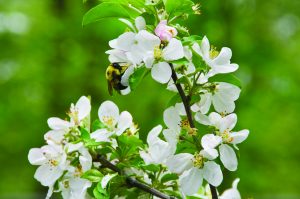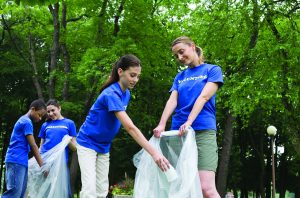
The Environmental Impact of Shopping Local
Shopping at locally owned businesses benefits everyone from local business owners to the people they employ to the communities where they operate. As beneficial as shopping local can be for small business owners and the communities where they operate, the planet is perhaps the biggest beneficiary of consumers supporting locally owned small businesses.
The environmental impact of purchasing locally manufactured and sold products is significant. Consumers who choose to use their purchasing power to support local businesses may not realize just how much they’re helping the planet in so doing.
• Shopping local reduces your “food miles.” Large grocery stores get much of their inventory from producers in other countries. Even stores that rely heavily on domestic producers may not limit their domestic partners to local farms. That means products may be traveling thousands of miles before they end up on the shelves in local grocery stores. This is often referred to as “food miles,” and the more consumers can reduce their food miles, the more they help the planet. The Center for Climate and Energy Solutions notes that transportation is the largest source of carbon emissions in the United States, so anything consumers can do to reduce the amount of fuel needed to get food from farm to table can greatly benefit the planet. Shopping local grocers who source their foods from local farms is a simple and effective way to help the planet.
• Shopping local conserves fuel. Much like shopping local reduces reliance on producers who must travel thousands of miles to get their products on shelves in your community, it also reduces the time consumers spend in their vehicles. That conserves fuel and helps to reduce air pollution. That’s an easily overlooked benefit of shopping local, but one that should not be taken for granted. According to the Union of Concerned Scientists, an estimated 150 million Americans are living in areas that do not meet federal air quality standards. Emissions from automobiles are a major source of the pollution that’s behind poor air quality, so anything consumers can do to reduce their fuel consumption, including shopping locally, can greatly benefit the planet.
• Shopping local protects land from developers. Another way shopping local benefits the planet is its link to preserving local farms. When local grocers get their foods from local farms, that increases the long-term sustainability of those farms. If farms are sustainable, they’re more likely to remain in operation. Farms don’t just grow foods, they also provide habitats for local wildlife that helps maintain local ecosystems. That domino effect begins with consumers who support local businesses by shopping local.
Shopping local pays numerous dividends, not the least of which are the many ways supporting local businesses benefits the environment.

Consumers who choose to use their purchasing power to support local businesses may not realize just how much they’re helping the planet in so doing.






Compost is Part of the Circle of Life in Gardens
The season for fresh fruits and vegetables grown right in the backyard is upon us. Warm weather breathes life into fresh berries, tomatoes, eggplant, cucumbers, and many other delectable fruits and vegetables.
Home gardens can be supplemented with delicious finds from the supermarket or farmer’s market, including melons, corn and more.
The bounty of the garden can be made more abundant and fruitful with the addition of the right soil amendments. Compost is a key element of rich, nutritious soil. Scraps from items that have been grown in the garden can then be reused in the production of the compost that feeds that same garden. It’s a continuous circle of garden life.
Getting started with compost is relatively easy. Homeowners should choose an outdoor space near the garden but far away from the home so that it won’t be disturbed by kids or animals. Some people opt for an open compost pile, while others choose closed bins to contain the possible smell and to camouflage the compost. A sunny spot will help the compost to develop faster, according to Good Housekeeping.
The next step is to start gathering the scraps and materials that will go into the compost. Better Homes and Gardens suggests keeping a bucket or bin in the kitchen to accumulate kitchen scraps. Here are some kitchen-related items that can go into the compost material:
· Eggshells
· Fruit peels
· Vegetable peels and scraps
· Coffee grounds
· Shredded newspaper
In addition to these materials, grass and plant clippings, dry leaves, bark chips, straw, and sawdust from untreated wood can go into the pile. Avoid diseased plants, anything with animal fats, dairy products, and pet feces.
A low-maintenance pile has an equal amount of brown and green plant matter in the compost plus moisture to keep the bacteria growing and eating at the right rate. Aerating the compost occasionally, or turning the bin when possible, will allow the compost to blend and work together. Compost will take a few months to form completely, says the Planet Natural Research Center. The finished product will resemble a dark, crumbly soil that smells like fresh earth.
Compost will not only add nutrients to garden soil, but also it can help insulate plants and may prevent some weed growth. It is a good idea to start a compost pile as a free source of nutrition for plants and a method to reduce food waste in an environmentally sound way.

The bounty of the garden can be made more abundant and fruitful with the addition of the right soil amendments. Compost is a key element of rich, nutritious soil.

How To Bring Beneficial Bees Back
Bees, birds and butterflies play integral roles in pollinating many of the crops humans rely on for sustenance. The National Pollinator Garden Network, through the National Wildlife Federation, recently launched the Million Pollinator Garden Challenge, an effort to increase the amount of nectar and pollen food sources as the organization aims to reverse the alarming decline of pollinators such as honey bees, native bees and monarch butterflies.
Many people are afraid of bees because of their propensity to sting. Unlike their wasp and yellow-jacket cousins, honeybees and bumblebees are much more docile and content to hop from bloom to bloom without paying humans any mind. The only time such bees may resort to stinging is if someone inadvertently steps on them.
Bees are beneficial for yards. Gardener’s Supply Company says one out of every three bites of food humans take depends on a pollinator. That’s because about 150 crops grown in the United States depend on pollinators. Even though there are 4,000 species of native or wild bees in the continental United States, many populations are in decline. According to the Pollinator Partnership, various areas of North America have lost more than 50 percent of their managed honeybee colonies in the past 10 years.
Bringing these important pollinators back will take a little work, but it is possible.
· Plants that offer cover can be attractive to bees that desire a respite from the sun and heat. Coleus and other ground cover offerings can be handy.
· Offer water in shallow dishes, as even bees need a cool drink to stay hydrated.
· Bees like various plants, so plant more than one species. Some plants that bees tend to like include alyssum, aster, geranium, bee balm, poppies, and clover.
· When planting, include some native species.
· Brush piles, dry grasses and dead woods offer nesting areas for bees.
· The Gardener’s Supply Company also says that bees find blue, purple and yellow flowers most appealing. Opt for more of these hues when planning gardens.
· Above all, avoid using pesticides in the yard. Even organic ones can be toxic to bees and other pollinators, and they may contribute to colony collapse disorder.
With these techniques in mind, homeowners can attract more bees to their yards and gardens, which can benefit bees and humans alike. TF196043

Unlike their wasp and yellow-jacket cousins, honeybees and bumblebees are much more docile and content to hop from bloom to bloom without paying humans any mind.





Meaningful Fun Ways To Celebrate Earth Day
Earth Day is a celebration of the planet that people, plants and animals call home. First celebrated in 1970, Earth Day was established to demonstrate support for environmental protection, and events are held each year on April 22. It is now coordinated globally by the Earth Day Network and celebrated in more than 193 countries.
People may wonder what they can do at a local level to make Earth Day a larger part of their lives. Here are just a few great ways to embrace Earth Day.
· Make it a point to bike or walk to school or work. If conditions are prohibitive, carpool to cut down on traffic. The fewer cars on the road, the less emissions in the air.
· Recycle e-waste in your home. E-waste is considered outdated electronic appliances that are no longer used. The Environmental Protection Agency suggests e-waste is the fastest growing waste stream in the world.
· Invest in a reusable coffee cup or water bottle. This can reduce the amount of trash that ultimately ends up in the environment.
· Connect with nature by turning off electronics for the day and getting outside. Head to a park or nature trail and immerse yourself in the great outdoors.
· Do something as simple as switching paper statements and bills to e-bills and online invoices. This reduces reliance on trees for new sources of paper.
· Grow some edibles in your home garden or even on a windowsill. This is a fun, eco-friendly way to control the foods you consume at home and a great way to save money as well.
· Reusing and recycling does not just pertain to water bottles and aluminum cans. Find out ways to repurpose or share items with others so they get more mileage. Also, make use of sharing services like bike sharing kiosks or Yerdle, an online community sharing marketplace.
· Volunteer your time at an organization that has an environmental focus. Or suggest a task with an eco-friendly slant, like picking up trash from a beach, to a local community group or club.
Earth Day is a great opportunity to get involved with environmental efforts. TF194887

People may wonder what they can do at a local level to make Earth Day a larger part of their lives. Here are just a few great ways to embrace Earth Day.
How To Build A More Energy-Efficient Home
(MS) – With weather forecasts calling for a warmer than normal summer and social distancing encouraging us to spend more time at home, we could all benefit from boosting our home’s energy efficiency to save on energy bills. Here are some big and small changes that could help:
Start with a solid foundation. If you’re adding an extension to your home, a pool to your backyard or even planning a custom-built dream home, choose sustainable materials that promote energy conservation. Instead of traditional wood-framing, consider insulated concrete forms from Nudura. The eco-friendly alternative features thermal mass walls that can reduce heating and cooling costs by up to 60 percent a year.
Work on your windows. Did you know that about 15 to 20 percent of your home’s surface is windows? This means any issues with them can have a major impact on your energy consumption. Take time to caulk any gaps or air leaks, and consider upgrading to energy-efficient windows. Double-paned windows boost your insulation and help ensure your cooled, air conditioned air doesn’t escape.
Switch to outdoor energy sources. Take advantage of the gorgeous weather to spend more time outside. Instead of cooking meals in your energy-intensive oven that also heats up your home, break out the barbecue and enjoy dinner al fresco. You can also ease up on the clothes dryer by setting up a line and some pins in the backyard and use the wind and sun for drying power.
Install a smart weather station. Technology can help you make sure you’re consuming energy wisely. A smart thermostat is a great idea, but a smart weather station can work with it and other devices to go a step beyond, programming them around current and predicted weather patterns. For example, it can ensure your scheduled sprinkler won’t go off in the middle of a downpour.
Be mindful of your refrigerator. If you aren’t careful, a lot of energy can be used by your fridge. First, make sure the one in your kitchen (and basement) is a newer model, as older ones can cost hundreds more a year to power. Then, clear it out so the shelves and drawers aren’t overcrowded, which makes the fridge work harder to pump cool air throughout. Finally, if you let leftovers cool on the counter before putting them inside, your fridge will use less energy.
Find more information at nudura.com. TF206078

With weather forecasts calling for a warmer than normal summer and social distancing encouraging us to spend more time at home, we could all benefit from boosting our home’s energy efficiency to save on energy bills.





Differences Between Organic & Inorganic Mulches
The benefits of mulch are widely known among lawn and garden enthusiasts. By insulating soil from extreme temperatures, helping soil to retain moisture and preventing weed growth, mulch can help plants, trees and gardens thrive, even during periods when Mother Nature can make that very difficult.
Novice gardners may find themselves a little confused when visiting a lawn and garden center to purchase mulch. That’s because there are various types of mulches. One of the ways to simplify that is to break mulches down into two main classes: organic and inorganic. Learning to distinguish between these two classes can help homeowners choose the best mulch for their properties.
Organic mulch
Organic mulches are made up of materials that decompose over time. The experts at BobVila.com note that, because they decompose over time, organic mulches must be replenished on a regular bais. Hardwood and softwood chips are among the most popular and recognizable organic mulches. Evergreen needles, leaves, grass clippings, and compost mixes also fall under the organic mulch umbrella. Many gardening enthusiasts prefer organic mulches because they help soil retain moisture, improve soil fertility and help to deter weed growth.
Inorganic mulches
Inorganic mulches are permanent because they do not decompose over time. Gravel, brick chips and crushed stone are examples of inorganic mulches. Homeowners who do not intend to plant after laying mulch may lean toward inorganic mulches, as they won’t require much work, if any, after being laid. However, the Chicago Botanic Garden notes that inorganic mulches do not improve soil quality. In fact, because inorganic mulches like rocks and stones absorb heat, they can be detrimental to plants in areas where weather tends to be very dry and hot.
The right mulch for a given property depends on a host of factors. Understanding the differences between organic and inorganic mulches is a great first step toward finding the right mulch for your landscape. GT204803

One of the ways to simplify that is to break mulches down into two main classes: organic and inorganic. Learning to distinguish between these two classes can help homeowners choose the best mulch for their properties.
How Environmental Consciousness Has Evolved
Reduce, reuse, recycle is a mantra for many people. It’s difficult to imagine that just 50 years ago awareness of the state of the environment was not part of the collective consciousness.
An emerging public consciousness about the planet began amid environmental issues like increased air pollution and massive consumption of fossil fuels in the 1960s. The bestselling book “Silent Spring” by Rachel Carson also raised public concern for living organisms and the links between pollution and public health. The push for environmental reform gained even more momentum on April 22, 1970, when the first Earth Day was celebrated. Then-Senator Gaylord Nelson from Wisconsin put Earth Day on the national stage following a large oil spill that struck off the coast of Santa Barbara, Calif. Before this disaster, recycling was not a word in the popular lexicon. But when the disaster struck, people began to reason that changes would have to be made to save the planet.
Since the first Earth Day 50 years ago, many strides have been made in the environmental movement. This grassroots initiative gave rise to the establishment of the Environmental Protection Agency, the Clean Air Act and the Clean Water Act. Environmental awareness has become much more mainstream and is a less polarizing issue than it was in the 1970s, although there are still debates about the reality of climate change and other risk factors. Public demand for environmental safeguards grew in the second half of the twentieth century, and those demands have grown stronger in recent years. Legislation is continually evolving to protect the air, land and water. Sustainability has joined the buzzwords of the movement, and most industries now have a vested interest in changes that can minimize risk to human health and the environment.
Mitigating or avoiding environmental effects, proper waste disposal, reduction in water discharge, and emphasis on reducing, reusing and recycling have become important components of environmental wellness. And people are being educated at earlier stages on the importance of environmental mindfulness. For example, core subjects of the environmental movement are increasingly covered in elementary schools.
Twenty million people turned out for the first Earth Day in the United States. Today, more than 190 countries are engaged and more than one billion individuals are mobilized for action every Earth Day, advises the Earth Day Network. To mark the 50th anniversary, the most pressing topic for the year is climate change. Climate Action is the 2020 Earth Day theme to engage the global public. There is still work to be done, but great progress has been made since 1970. TF204864

It’s difficult to imagine that just 50 years ago awareness of the state of the environment was not part of the collective consciousness.







How to Reduce Food Waste
Perhaps nothing can spoil an appetite more than a crisper drawer full of fresh vegetables that have taken a turn for the worse. Spoiled food is not just unsafe to eat, but it is also very costly.
The Academy of Nutrition and Dietetics Foundation and the U.S. Department of Agriculture estimate that the average family of four throws out nearly $1,500 worth of food and beverages each year. That means that, within seven years, the average family has spent more than $10,000 on food they did not eat.
In recognition of the problems posed by food waste, the National Grange, the oldest farm and food advocacy organization in the United States, aims to create a cultural shift that reduces food waste. Individual consumers can do their part in supporting that shift by taking various steps to reduce food waste in their homes.
· Take inventory before going to the grocery store. An inventory of the refrigerator and pantry can help shoppers avoid buying items they already have. This is especially valuable at reducing food waste in regard to perishable items that can spoil before shoppers have a chance to eat them.
· Make a meal plan and grocery list. The Environmental Protection Agency notes that meal plans and accompanying grocery lists help consumers reduce food waste and save money by decreasing the likelihood that they will buy items they won’t need for the meals they plan to eat in the week ahead.
· Purchase frozen foods. Organic, fresh vegetables eaten when they are most ripe may be the healthiest way to eat vegetables. However, frozen vegetables still have ample nutritional value, and may even boast a higher nutritional value than off-season, fresh vegetables sold at the grocery store. That’s because frozen fruits and vegetables are picked when they’re ripe and then immersed in boiling water to kill bacteria and prevent enzyme activity that can spoil food. They’re then immediately flash frozen, a process that typically preserves nutrients. The long shelf life of frozen fruits and vegetables reduces the likelihood that shoppers will throw them out before eating them. That’s not the case with fresh vegetables, which the ANDF and the USDA note account for more than 30 percent of food waste each year.
· Wash berries only as you eat them. When eating fresh berries, wait to wash them until you eat them. The risk of mold forming increases when washing an entire container all at once, whereas only washing the berries as they’re eaten increases the likelihood that they won’t spoil before they’re all eaten.
Food waste is a global problem that can be fixed. And that solution can start in the kitchens of consumers willing to do their part. TF204851

Individual consumers can take various steps to reduce food waste in their homes.
What Are Microplastics?
The world’s oceans face threats on many fronts. Water pollution and air pollution pose significant dangers to oceans and the marine life that call them home, but a much smaller threat is having its own devastating impact on the world’s oceans.
The National Oceanic and Atmospheric Administration acknowledges that not much is yet known about microplastics, which are small pieces of plastic less than five millimeters long. Though much about microplastics remains unknown, researchers do know that these tiny pieces of plastic can be harmful to the oceans and marine life.
Where do microplastics come from?
National Geographic reports that microplastics are categorized as primary or secondary. Primary microplastics are tiny particles designed for commercial use and can include microfibers shed from clothing. Microfibers shed from fishing nets are another example of primary microplastics.
Secondary microplastics develop after larger plastic items break down. For example, some microplastics form as plastic water bottles break down, while others are byproducts of the breakdown of plastic bags, such as those used in grocery stores.
Why are microplastics so threatening?
It might seem odd that something smaller than five millimeters, or 0.2 inches, can pose such a significant threat to something as vast as the ocean. However, despite their size, microplastics still take thousands of years to decompose. In the meantime, microplastics find their way into everything from plankton to whales to the foods we eat and the water we drink. The NOAA notes that microbeads are a type of microplastic that pass through water filtration systems, ultimately ending up in oceans and even lakes, where they pose a threat to marine life. Microplastics like microbeads have been detected in commercial seafood, meaning that anyone who eats fish could inadvertently and unknowingly be consuming plastic as well.
Are microplastics dangerous to humans?
Anything that poses a threat to the world’s oceans and the marine life that live in those waters is dangerous to humans. Oceans produce more than half of the world’s oxygen, and medicinal products used to fight diseases like cancer also rely on ingredients found in the ocean. Therefore, when the oceans are in danger, so, too, are humans.
The use of plastic microbeads in certain products was banned in the United States in 2015, which reflects the concerns environmentalists and public health officials have in regard to microplastics. And though National Geographic notes that researchers are still uncertain about how consuming microplastics affects the human body, many nations like the United States are erring on the side of caution and increasingly banning the use of microplastics.
Microplastics pose a potentially significant danger to the environment. More information about microplastics can be found at www.oceanservice.noaa.gov. TF216037

Though much about microplastics remains unknown, researchers do know that these tiny pieces of plastic can be harmful to the oceans and marine life.


